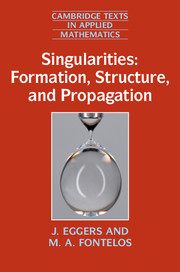Book contents
- Frontmatter
- Dedication
- Contents
- Preface
- PART I SETTING THE SCENE
- PART II FORMATION OF SINGULARITIES
- 7 Drop breakup
- 8 A numerical example: drop pinch-off
- 9 Slow convergence
- 10 Continuation
- PART III PERSISTENT SINGULARITIES: PROPAGATION
- Appendix A Vector calculus
- Appendix B Index notation and the summation convention
- Appendix C Dimensional analysis
- References
- Index
10 - Continuation
from PART II - FORMATION OF SINGULARITIES
Published online by Cambridge University Press: 05 September 2015
- Frontmatter
- Dedication
- Contents
- Preface
- PART I SETTING THE SCENE
- PART II FORMATION OF SINGULARITIES
- 7 Drop breakup
- 8 A numerical example: drop pinch-off
- 9 Slow convergence
- 10 Continuation
- PART III PERSISTENT SINGULARITIES: PROPAGATION
- Appendix A Vector calculus
- Appendix B Index notation and the summation convention
- Appendix C Dimensional analysis
- References
- Index
Summary
An important issue is what happens after a singularity has occurred. A very simple example was considered in Section 3.5; now we will turn to some physical examples in more detail. First, we consider the breakup of a liquid drop, which marks the transition from one piece to two separate pieces of liquid. To know how the two pieces evolve after breakup one needs to continue across the singularity. In particular, is the continuation unique or are there several possible ways for the solution to evolve after the singularity? As in Section 3.5 we will consider two very different approaches to continuation. In the first approach we construct a similarity solution that applies directly after the singularity, by solving two separate problems corresponding to the two pieces resulting from breakup. We show that they are determined uniquely by the pre-breakup dynamics. In the second approach we regularize the equations on a small scale, so that a true singularity never occurs.
Post-breakup solution: viscous thread
In Chapter 7 we saw that the asymptotics of drop breakup is described by the similarity solution (7.41). We described in some detail how a unique, stable, similarity solution is selected; this is shown in Fig. 7.3. Now we show how the knowledge of the pre-breakup solution permits us to construct a unique post-breakup solution. The strategy has already been laid out and hinges on the matching conditions (3.84), which transfer information about the behave-ior of the pre-breakup solution far from the pinch point to the post-breakup solution.
However, there remains a technical challenge, illustrated in Fig. 10.1. In the immediate neighborhood of the tip, where the slope h′ of the profile diverges, the solution can no longer be considered slender. As a result the derivation of the slender jet equations (6.57), (6.58) is not valid; the equations break down at the tip. Instead, we must consider a separate tip region, whose width tip is comparable with its radial extension. In the language of matched asymptotics the tip is the inner region, while the receding thread, over which the slender jet approximation applies, is the outer region.
- Type
- Chapter
- Information
- Singularities: Formation, Structure, and Propagation , pp. 230 - 256Publisher: Cambridge University PressPrint publication year: 2015

